
Kumbakonam, or Kudanthai, is a city municipal corporation in the Thanjavur district in the Indian state of Tamil Nadu. It is located 40 km (25 mi) from Thanjavur and 282 km (175 mi) from Chennai and is the headquarters of the Kumbakonam taluk of Thanjavur district. It is the second largest city in the district after Thanjavur. The city is bounded by two rivers, the Kaveri River to the north and Arasalar River to the south. Kumbakonam is known as a "Temple town" due to the prevalence of a number of temples here and is noted for its Mahamaham festival, which happens once in 12 years, attracting people from all over the country.
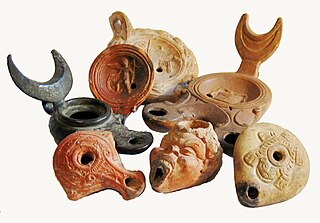
An oil lamp is a lamp used to produce light continuously for a period of time using an oil-based fuel source. The use of oil lamps began thousands of years ago and continues to this day, although their use is less common in modern times. They work in the same way as a candle but with fuel that is liquid at room temperature, so that a container for the oil is required. A textile wick drops down into the oil, and is lit at the end, burning the oil as it is drawn up the wick.

Bronze is the most popular metal for cast metal sculptures; a cast bronze sculpture is often called simply "a bronze". It can be used for statues, singly or in groups, reliefs, and small statuettes and figurines, as well as bronze elements to be fitted to other objects such as furniture. It is often gilded to give gilt-bronze or ormolu.
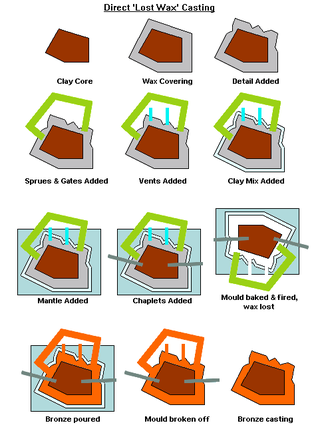
Lost-wax casting – also called investment casting, precision casting, or cire perdue – is the process by which a duplicate sculpture is cast from an original sculpture. Intricate works can be achieved by this method.
Ceramic forming techniques are ways of forming ceramics, which are used to make everything from tableware such as teapots to engineering ceramics such as computer parts. Pottery techniques include the potter's wheel, slip casting and many others.
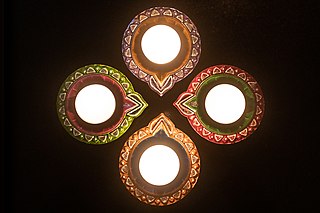
A diya, diyo, deya, deeya, dia, divaa, deepa, deepam, deep, deepak or saaki is an oil lamp made from clay or mud with a cotton wick dipped in oil or ghee. These lamps are commonly used in the Indian subcontinent and they hold sacred prominence in Hindu, Sikh, Buddhist, and Jain prayers as well as religious rituals, ceremonies and festivals including Diwali.

Candle making was developed independently in a number of countries around the world.
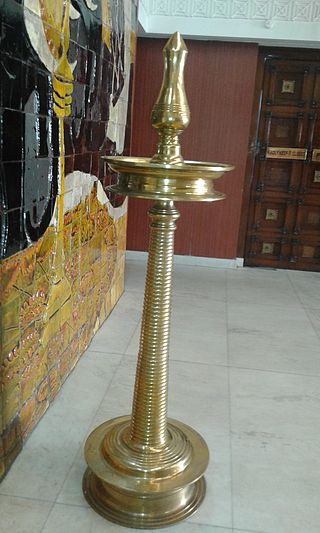
Nilaviḷakku is a traditional lamp used commonly in Kerala as well as in Tamil nadu, called Kuthuviḷakku in Tamil (குத்துவிளக்கு). It is called Deepada Kamba in Karnataka and Samai (समई) in Maharashtra. In Odisha, its called Pilisajā/Pilibeṛhi in Odia. The traditional lamps which is lit during every auspicious occasions; in temples before the worship starts; at the official and unofficial functions.

Bidriware is a metal handicraft from the city of Bidar in Karnataka, India. It was developed in the 14th century C.E. during the rule of the Bahmani Sultans. The term "bidriware" originates from the township of Bidar, which is still the chief center of production. The metal used is white brass that is blackened and inlaid with silver. As a native art form, Bidriware obtained a Geographical Indications (GI) registry on 3 January 2006.

Dhokra is non–ferrous metal casting using the lost-wax casting technique. This sort of metal casting has been used in India for over 4,000 years and is still used. One of the earliest known lost wax artefacts is the dancing girl of Mohenjo-daro. The product of dhokra artisans are in great demand in domestic and foreign markets because of primitive simplicity, enchanting folk motifs and forceful form. Dhokra horses, elephants, peacocks, owls, religious images, measuring bowls, and lamp caskets etc., are highly appreciated. The lost wax technique for casting of copper based alloys has also been found in China, Egypt, Malaysia, Nigeria, Central America, and other places.

Casting is a manufacturing process in which a liquid material is usually poured into a mold, which contains a hollow cavity of the desired shape, and then allowed to solidify. The solidified part is also known as a casting, which is ejected or broken out of the mold to complete the process. Casting materials are usually metals or various time setting materials that cure after mixing two or more components together; examples are epoxy, concrete, plaster and clay. Casting is most often used for making complex shapes that would be otherwise difficult or uneconomical to make by other methods. Heavy equipment like machine tool beds, ships' propellers, etc. can be cast easily in the required size, rather than fabricating by joining several small pieces. Casting is a 7,000-year-old process. The oldest surviving casting is a copper frog from 3200 BC.
Kammalar is a Tamil caste group found in the Indian state of Tamil Nadu and in northeastern Sri Lanka. The Kammalars are involved in crafting. Kammalar is a generic term that comprises the communities of Kannar (brass-workers), Kollar (blacksmiths), Tarar (goldsmiths), Tatchar (carpenters) and Kartatchar (sculptors). Kammalars are classified and listed as Backward Class by both the central government of India and the State governments of Tamil Nadu and Kerala They worship various forms of this deity.
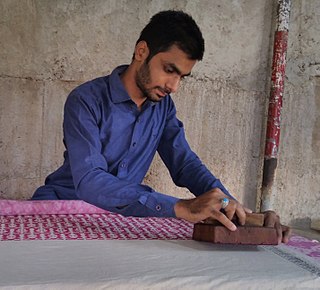
The crafts of India are diverse, rich in history, culture and religion. The craft of each state in India reflect the influence of different empires. Throughout centuries, crafts have been embedded as a culture and tradition within rural communities.

Thanjavur Art Plate is an artifact exclusively made in the Thanjavur region of Tamil Nadu, India. It is a circular plate consisting of silver, bronze, and copper embossed with figures of Hindu gods and goddesses at its center. The artwork has been registered for protection under the Geographical indication of the Trade Related Intellectual Property Rights (TRIPS) agreement. It is listed at item 63 of the Geographical Indications Act 1999 of the Government of India, with registration confirmed by the Controller General of Patents Designs and Trademarks in 2007-08. While the size of the article is permitted to be different, metal compositions and particularization have to remain the same to be identified with the unique indicator as per GI approval.

Swamimalai Bronze Icons refers to bronze idols and statues manufactured in Swamimalai, Tamil Nadu. It has been recognized as a Geographical indication by the Government of India in 2008–09.

Brass broidered coconut shell craft of Kerala is the craft of making beautifully carved and brass broidered products like cups, flower vases, snuff boxes, nut bowls, powder boxes and spoons using coconut shells as practiced by the artisans of Kerala in India. This art requires great skill on the part of the artisan as the shell is extremely hard. The main centres of production in Kerala are located in Thiruvananthapuram and Kozhikode Districts. Though the coconut shell craft is also prevalent in Goa, Tamil Nadu, Pondicherry, Andaman and Nicobar Islands and West Bengal, the brass broidered variety is practiced only in Kerala.
Budithi Bell and Brass Craft are the products made out of alloy like brass at Budithi, a village in Srikakulam district of the Indian state of Andhra Pradesh. It was registered as one of the geographical indication handicraft from Andhra Pradesh as per Geographical Indications of Goods Act, 1999. It was registered as one of the handicraft in the geographical indication from Andhra Pradesh by Geographical Indications of Goods Act, 1999.
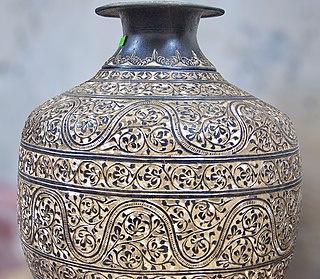
The brassware industry in Bangladesh is considered as a cottage industry and artisans with high workmanship make brass crafts by hand. The brassware of Bangladesh has good reputation in international market for uniqueness.

Pakistani craft has a rich history and deep-rooted tradition. It involves the creation, design, and shaping of objects by hand or with simple tools, selecting the artisanal sills of Pakistani people. Typically crafted by individuals, groups, or independent artisans, this age-old practice employs traditional materials like brass, wood, clay, textiles, paper, and embroidery. Popular techniques include stone carving, working with sandstone and onyx, metalwork, pottery, and the intricate art of Ajrak, all contributing to Pakistan's vibrant handicraft culture.

















